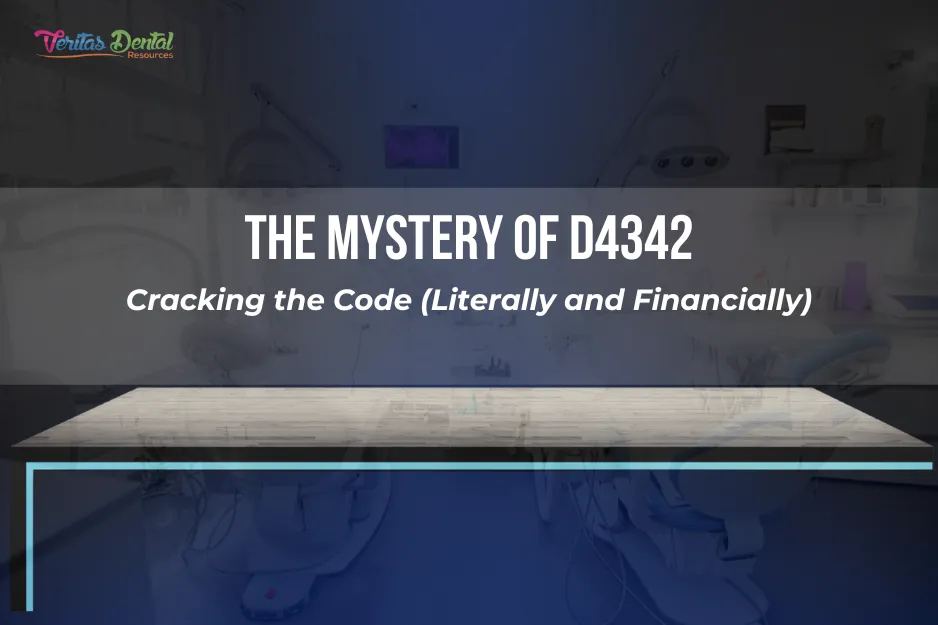
The Mystery of D4342: Cracking the Code (Literally and Financially)
Let’s face it—CDT codes can feel like you need a secret decoder ring just to make sense of them. And if there's a code that often trips up dental teams and gets claim adjusters grinning behind their computer screens, it's D4342: Periodontal Scaling and Root Planing – one to three teeth per quadrant.
Unlike its big sibling D4341, which covers four or more teeth per quadrant, D4342 is the mini but mighty version, and when used correctly, it can protect your office’s revenue and give your patients the periodontal care they need.
💡 First Things First: What Is D4342?
D4342 is the code you’ll use when scaling and root planing is required, but the disease is localized to just one to three teeth in a single quadrant. These are sites showing clinical signs of periodontitis, such as:
Pocket depths ≥ 4–5mm
Bleeding on probing
Subgingival calculus
Bone loss visible on radiographs
And here’s the kicker: you must document this carefully. Because without chart notes, perio charting, radiographs, and justification, insurance companies will treat this code like it’s an imaginary friend.
🧩 The D1110 + D4342 Conundrum
Here’s where things get spicy…
Let’s say your patient needs a prophy (D1110), but also has two periodontally-involved teeth in the upper right quadrant. You decide to scale those two teeth with D4342, and then perform a prophy on the rest of the mouth.
Seems reasonable, right? Well, welcome to the dark arts of dental insurance, where logic doesn’t always win.
😖 Will Insurance Pay for Both?
Here’s the short answer: sometimes yes, sometimes no.
Many insurance carriers deny D1110 when billed on the same date of service as D4342, claiming they are “mutually exclusive procedures” or “incompatible on the same DOS”—even when they apply to different teeth.
Why? Because some carriers argue that when periodontal scaling is done in any part of the mouth, a prophy becomes unnecessary or redundant—even if the rest of the mouth is healthy and requires routine maintenance.
💸 How to Increase Your Odds of Getting Paid for Both D1110 + D4342:
Submit a detailed narrative.
Explain that D4342 was performed on 1–3 localized teeth in a specific quadrant, while D1110 was completed on the remaining teeth in the other quadrants. Be clear and clinical.📝 Example Narrative:
“Patient presents with localized moderate periodontitis in UR quadrant affecting #3 and #4 with 5mm pockets, BOP, and subgingival calculus. SRP performed on #3 and #4 (D4342). Remaining dentition presented with healthy gingiva and no clinical signs of periodontal disease; D1110 performed accordingly.”Include documentation.
You’ll want to submit:Full-mouth perio charting
X-rays showing bone loss
Intraoral photos, if available
Clinical notes specifying the teeth treated and the rationale
Consider separate appointments if your payer is particularly stubborn.
Some offices get paid more reliably by reappointing the patient for the prophy 7–14 days after the D4342 treatment. (Yes, this is frustrating, but if it secures payment, it’s worth considering.)
⚠️ Pro Tip:
Call the payer or check their provider manual to see if they allow D1110 and D4342 on the same DOS. Some do, with documentation. Others flat-out refuse—know before you go!
🛡️ Documentation Tips That Protect You (and Get You Paid):
Don’t “stack codes” without clinical need. Insurance sniffs out misuse of D4342 if you're using it frequently but not backing it up with good records.
Make your perio charting specific. Show why only 1–3 teeth needed SRP.
Use intraoral camera images to prove subgingival calculus or inflammation.
🧠 Bonus Insight: What About When It’s Just One Tooth?
Yes, you can use D4342 for just a single tooth with periodontal disease. That’s the beauty of this code. If tooth #19 is waving the periodontal flag alone in the lower left, D4342 still applies.
💬 Just be ready to explain why that one tooth went rogue.
🚫 Common Mistakes to Avoid:
Using D4342 without a perio chart (instant denial)
Billing D4342 and D1110 on the same day without documentation (likely denial)
Performing D4342 on teeth without actual periodontitis (risky at best, fraudulent at worst)
Thinking D4342 is just a "mini-prophy" (nope—different procedure, different disease process)
🏁 Final Thoughts
D4342 is one of those CDT codes that can do a lot of good for your patients and your practice—but it demands precision. Use it wisely, back it up fiercely, and don’t be afraid to challenge denials with facts, not frustration.
Because in this insurance game, clinical clarity and ironclad documentation are your best friends.
Benjamin Tuinei
Founder - Veritas Dental Resources, LLC
Phone: 888-808-4513
Services:
PPO Fee Negotiators | PPO Fee Negotiating | Insurance Fee Negotiating
Insurance Credentialing | Insurance Verifications
Websites:
www.VeritasDentalResources.com | www.VerusDental.com

